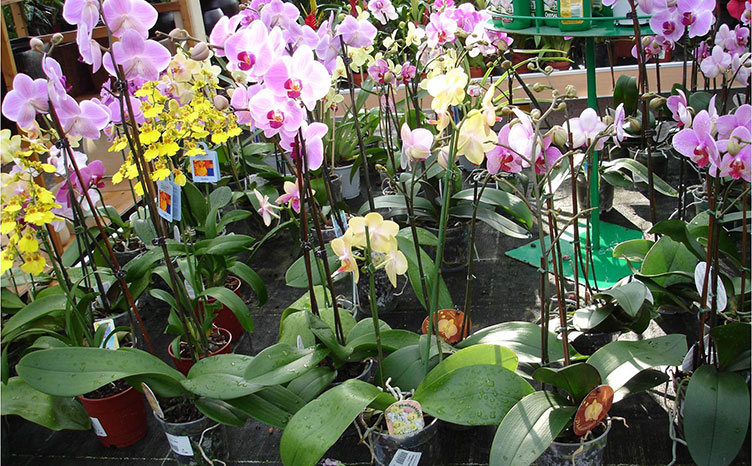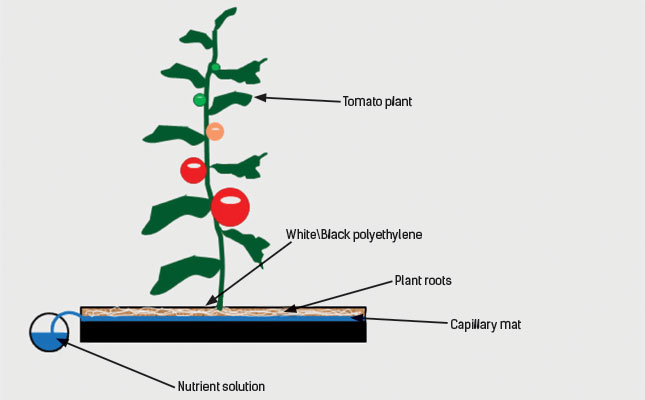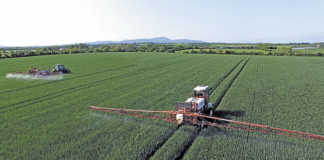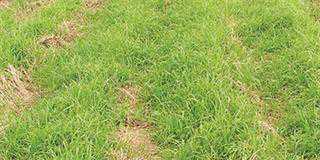
Semi-hydroponic systems are often referred to as passive sub-irrigation hydroponics. I prefer to refer to this group of hydroponic systems as capillary hydroponics, which better describes what it entails.
Capillary hydroponics is a method whereby plants are grown with their roots in contact with an inert porous medium or polymer film that transports the nutrient solution by capillary action to the plant root zones from a separate reservoir nearby.
This system provides the plant roots with a continuous supply of water and nutrients without the assistance of a pump, thus reducing the labour involved.
Wick System
The simplest capillary system is the so-called wick system, which has no moving parts or pumps, and requires no external energy or electricity for its operation.
It is useful for small-scale and low-cost hydroponic applications in areas where power is too expensive, unreliable or not available at all.
A wick hydroponic system is easy to build and operate, and is often used by beginners starting out with hydroponics. The system can also be used to introduce learners to hydroponics by demonstrating how easy it is to grow plants hydroponically.
To build your own wick hydroponic system you will need:
- A container for the plant;
- A container or reservoir for the nutrient solution;
- A suitable substrate or growth medium, such as fine sand, sawdust, cocoa coir, vermiculite or perlite;
Some strips of material such as felt or a thick piece of rope with the necessary wicking action to transport the nutrient solution from the reservoir to the plants by capillary action.
This is similar to the way in which the molten wax of a candle is transported through the wick towards the flame.
As the wick absorbs the water and nutrients like a sponge and supplies it to the plants, the container in which the plants are situated should be placed directly above the reservoir containing the nutrient solution.
The system may require two or more reasonably sized wicks to supply enough water and nutrients to the plants.
The biggest drawback of this simple hydroponic wick system is that it is not always suitable for larger plants such as tomatoes or cucumbers. These plants are heavy feeders that need more water and nutrients than smaller, non-fruiting plants such as lettuce, spinach or various herbs.
Another disadvantage of wick systems is the potential build-up of mineral salts in plants’ root zones. This occurs when plants absorb uneven portions of nutrients and water. Plants absorb only the nutrients and water that they require and leave the rest of the nutrients to build up in the substrate or growth medium.
This can eventually cause a toxic build-up of mineral salts in the substrate, which then requires regular flushing of the system with fresh water weekly or bi-weekly.
The wick is probably the most important part of the system. It should consist of an absorbent type of material to ensure that the plants get enough moisture and nutrients to satisfy their needs.
However, the material should not be prone to rotting. Some growers use fibrous rope, propylene felt strips, rayon rope, mop head strands, wool or felt. Even old clothing or blankets (cut into strips) could be used.
The substrate should also be absorbent, with good water-holding capacity to continue the wicking action in the root zone. The reservoir must be large enough to hold enough water and nutrients so that it never runs dry.
You will need to top up the nutrient solution in the reservoir from time to time so that it does not need to travel too far upwards to reach the roots of the plants.
There is no need to use an air pump and air stone to aerate the water in a wick system, but it can be beneficial.
Capillary Pot system
In the simplest capillary pot hydroponic system, the pots sit in a shallow nutrient solution or on a capillary mat saturated with nutrient solution.

The various substrates that are available for this system include expanded clay, coco fibre, sawdust, fine sand, and a host of other fine materials that contain more air space than traditional potting mixes to ensure an increased oxygen supply to the roots.
Growers of certain epiphytes on plants such as orchids and bromeliads often prefer this method, as it exposes the plant roots to the surrounding air in their natural habitat.
The system is also a traditional method for the production of potted plants, benefitting from reduced levels of root rot and the additional ambient humidity provided through evaporation from the capillary mat or nutrient solution.
Keeping bacteria at bay
The capillary pot system (see diagram) allows the water and nutrients to pass to the roots, while preventing bacteria and other pathogens from damaging the roots. There is also no risk of bacteria entering the system, which reduces the amount of agrochemicals needed.
This system creates a moderate degree of ‘water stress’, which improves the taste of fruit-bearing crops such as tomatoes by stockpiling nutrients, resulting in fruit with copious amounts of sugar and amino acids.
Email Prof Gert Venter at [email protected].













